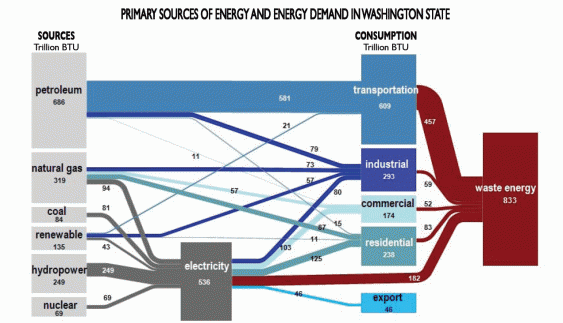There’s much to recommend in Washington’s state energy strategy, but the most arresting element is one that doesn’t get much attention: almost half of all the energy in Washington is wasted.
That may sound preposterous, but in fact it’s an understatement. To understand what’s going on, feast your eyes on this graphic:
[Click the image for a bigger version.]
This is a picture of Washington’s energy system. On the left in gray are the primary energy sources used by the state in 2009—oil, gas, coal, nuclear, hydro, and other renewables. Of the 1,543 trillion BTUs used to produce energy, 536 were used to generate electricity. But more than one-third of the energy used to generate electricity was wasted, mostly as unused exhaust from boilers and combustion turbines but also a bit from transmission wires.
Yet the electric sector, wasteful as it is, is actually pretty efficient relative to some of the end-use sectors like transportation, shown in blue.
Consider: the state burned through 609 trillion BTUs of energy, almost entirely petroleum-based, to move cars, trucks, trains, planes, and boats. But fully three-quarters of the energy used to power our vehicles was wasted. As the report explains:
The vast majority of energy used is never applied to moving vehicles and ends up being lost as waste heat. The primary reason for that loss is that the majority of vehicles in use are direct-drive internal combustion engines, which deliver, on average, barely 25 percent of the energy in the fuel to the wheels on the road.
Transportation energy is particularly problematic. It may amount to only one-third of the state’s total energy usage, but it accounts for 45 percent of Washington’s greenhouse gas emissions (even counting non-energy ghgs) and 60 percent of its energy expenditures. Virtually all transportation energy is oil-based and Washington produces no oil, which means that the vast majority of that expenditure is leaving the state. And the notorious volatililty of oil prices means that more than half the state’s energy expenditures are unpredictable and economically risky.
The other end-use sectors—industrial, commercial, and residential—consumed 705 trillion BTUs in aggregate, but wasted about 28 percent of that. If that sounds pretty good, it’s not. It’s terrible. That 28 percent waste figure covers only equipment inefficiency; it doesn’t account for heat loss from poorly insulated buildings, inefficient building design, or poor building management like heating unused rooms or leaving the lights on. If those other forms of waste were tallied, the true waste from these sectors would be much, much higher.
What does it all add up to? Colossal waste. Excluding energy exports, Washington wastes 45 percent of the energy used in transportation, buildings, industry, and electricity generation. Factor out the complications of the electric sector, and the state is wasting 50 percent of the energy it consumes. (Again, not including wasteful practices or inefficiently constructed buildings.)
This isn’t just a waste of natural resources and carbon, it’s a huge waste of money. Energy isn’t exactly free, and particularly not in a state that can supply none of its own oil, coal, or natural gas—fossil fuels that Washington spends roughly $16 billion annually to import.
Wasting half of our energy is an ongoing economic drain. In fact, if a person wanted to improve the state’s economy, it’s hard to think of a better strategy than cutting energy waste.



Comments are closed.